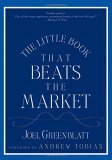With a title like “The Little Book That Beats the Market”, this book might appear to be peddling nothing more than snake oil to gullible people looking to make money from the stock market. It still merits a look since the author Joel Greenblatt is a respected value investor and a professor, who started and managed the hedge fund Gotham Capital that achieved an average annual return of 40% over more than 20 years.
The book recommends a very simple strategy - buying good companies at bargain prices. A “good company” is defined as one that has provided an above-average return on capital in the recent past. A stock has a “bargain price” if the earnings per share is much more than that from a relatively risk-free investment like US Treasury bonds. The book provides a “magic formula” that ranks companies according these critera so that the reader can build a suitable portfolio based on the principles given in the book. There is also a website called “Magic Formula Investing” that makes it very easy to apply the magic formula to US stocks.
The author shows that this strategy has worked consistenly over the long term with a suitably diversified portfolio (the top 20 to 30 stocks picked according to the magic formula) when compared to the returns from the overall market and the S&P 500. Appendices in the book provide more precise definitions of the criteria used by the magic formula for those familiar with financial terms and answers to the usual criticisms of formula-based investing.
If the formula is so simple and seems to work so consistently, wouldn't everyone start using it and thus reduce its effectiveness? The answer seems to be that the magic formula only works in the long term (3 to 5 years) - in the short term it might perform much worse than the market. It thus requires a significant amount of patience that most people lack. For the same reason, professional money managers cannot use this formula since most clients pull out their money if a fund doesn't perform well over a relatively short term.
How is it possible to pick stocks at bargain prices? Aren't markets supposed to be efficient since the interaction of a large number of knowledgeable buyers and sellers ensures that a stock is priced at its fair value? Even if the market underprices a stock, what is the guarantee that it will ever offer a fair value for that stock? The answers to these questions seem to be in the observation that the markets behave irrationally over the short term (driven by the prevailing sentiments), but usually behave rationally over the long term. It is not always necessary that a given stock achieves its fair value over the long term or that the company continues to perform as well as it has in the past, so it is necessary to hold a suitably diversified portfolio of such stocks to guard against these risks.
The best part about this book is that it uses a simple language that can easily be understood by laymen. As the title suggests, it is indeed a little book that comprises easy to digest short chapters. It explains the principles behind the magic formula using easy to understand examples. It answers almost all the questions that you are likely to come up with as you read the chapters.
The only major complaint I have with the book is that the tone of the writing seems to be a bit condescending. I would also have liked each chapter to have a title. The title of the book as well as the term “magic formula” are a bit too provocative for my tastes. Be that as it may, I would still highly recommend this book if you are interested in investing in the stock market.
There is also an Indian hard-cover edition of this book (ISBN: 81-265-0797-7) that has a surprisingly good quality of paper and print for its price. I do not yet know of a website that applies the magic formula to Indian stocks.
